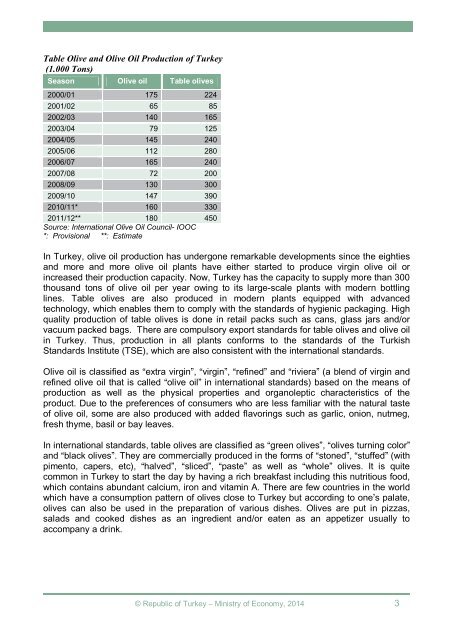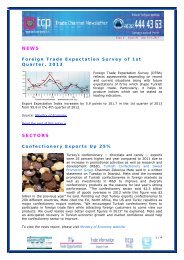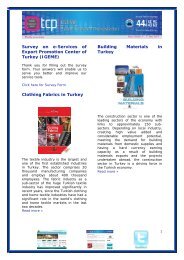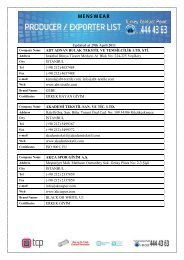olive oil and table olives - Turkey Contact Point
olive oil and table olives - Turkey Contact Point
olive oil and table olives - Turkey Contact Point
Create successful ePaper yourself
Turn your PDF publications into a flip-book with our unique Google optimized e-Paper software.
Table Olive <strong>and</strong> Olive Oil Production of <strong>Turkey</strong>(1.000 Tons)Season Olive <strong>oil</strong> Table <strong>olive</strong>s2000/01 175 2242001/02 65 852002/03 140 1652003/04 79 1252004/05 145 2402005/06 112 2802006/07 165 2402007/08 72 2002008/09 130 3002009/10 147 3902010/11* 160 3302011/12** 180 450Source: International Olive Oil Council- IOOC*: Provisional **: EstimateIn <strong>Turkey</strong>, <strong>olive</strong> <strong>oil</strong> production has undergone remarkable developments since the eighties<strong>and</strong> more <strong>and</strong> more <strong>olive</strong> <strong>oil</strong> plants have either started to produce virgin <strong>olive</strong> <strong>oil</strong> orincreased their production capacity. Now, <strong>Turkey</strong> has the capacity to supply more than 300thous<strong>and</strong> tons of <strong>olive</strong> <strong>oil</strong> per year owing to its large-scale plants with modern bottlinglines. Table <strong>olive</strong>s are also produced in modern plants equipped with advancedtechnology, which enables them to comply with the st<strong>and</strong>ards of hygienic packaging. Highquality production of <strong>table</strong> <strong>olive</strong>s is done in retail packs such as cans, glass jars <strong>and</strong>/orvacuum packed bags. There are compulsory export st<strong>and</strong>ards for <strong>table</strong> <strong>olive</strong>s <strong>and</strong> <strong>olive</strong> <strong>oil</strong>in <strong>Turkey</strong>. Thus, production in all plants conforms to the st<strong>and</strong>ards of the TurkishSt<strong>and</strong>ards Institute (TSE), which are also consistent with the international st<strong>and</strong>ards.Olive <strong>oil</strong> is classified as “extra virgin”, “virgin”, “refined” <strong>and</strong> “riviera” (a blend of virgin <strong>and</strong>refined <strong>olive</strong> <strong>oil</strong> that is called “<strong>olive</strong> <strong>oil</strong>” in international st<strong>and</strong>ards) based on the means ofproduction as well as the physical properties <strong>and</strong> organoleptic characteristics of theproduct. Due to the preferences of consumers who are less familiar with the natural tasteof <strong>olive</strong> <strong>oil</strong>, some are also produced with added flavorings such as garlic, onion, nutmeg,fresh thyme, basil or bay leaves.In international st<strong>and</strong>ards, <strong>table</strong> <strong>olive</strong>s are classified as “green <strong>olive</strong>s”, “<strong>olive</strong>s turning color”<strong>and</strong> “black <strong>olive</strong>s”. They are commercially produced in the forms of “stoned”, “stuffed” (withpimento, capers, etc), “halved”, “sliced”, “paste” as well as “whole” <strong>olive</strong>s. It is quitecommon in <strong>Turkey</strong> to start the day by having a rich breakfast including this nutritious food,which contains abundant calcium, iron <strong>and</strong> vitamin A. There are few countries in the worldwhich have a consumption pattern of <strong>olive</strong>s close to <strong>Turkey</strong> but according to one’s palate,<strong>olive</strong>s can also be used in the preparation of various dishes. Olives are put in pizzas,salads <strong>and</strong> cooked dishes as an ingredient <strong>and</strong>/or eaten as an appetizer usually toaccompany a drink.© Republic of <strong>Turkey</strong> – Ministry of Economy, 2014 3
















